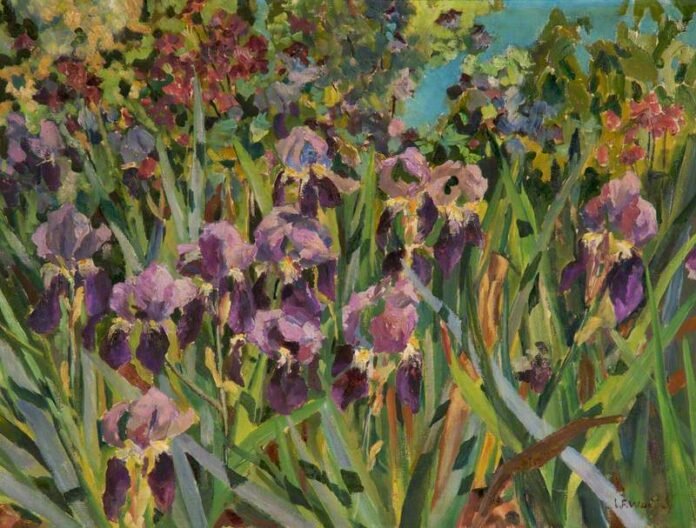Impressionism, a 19th-century art movement, sought to capture the essence of a moment through light, color, and everyday subjects. Among the many natural elements that captivated the Impressionists, flowers held a special place. Claude Monet, one of the movement’s leading figures, frequently depicted the flora of his garden in Giverny. Irises, in particular, feature prominently in his work, symbolizing the delicate interplay of light and color that defines Impressionist art. This article explores the significance of irises in Monet’s work and other Impressionist paintings, focusing on their symbolism and aesthetic appeal.
Irises in Monet’s “Garden” Artwork
Claude Monet’s garden in Giverny was not just a personal retreat but a living canvas that inspired many of his masterpieces. The irises in Monet’s garden were a recurring motif in his artwork, symbolizing renewal, beauty, and the ephemeral nature of life. Monet’s “Garden” artwork often features these vibrant blooms, showcasing their elegant forms and rich colors.
In his painting “Irises in Monet’s Garden,” Monet captures the irises’ vivid hues and delicate structure. The painting’s composition emphasizes the irises’ vertical lines, contrasting with the softer, more diffuse background of greenery and sky. This juxtaposition highlights the flowers’ graceful presence, drawing the viewer’s eye and creating a sense of depth and movement.
Monet’s technique of using short, quick brushstrokes allows the colors to blend optically, giving the impression of light dancing across the petals. This method, a hallmark of impressionism art, helps convey the transient beauty of the irises, reflecting the changing light and seasons.

The Symbolism of Irises
In art, irises often symbolize hope, faith, and wisdom. Their name derives from the Greek word for rainbow, reflecting their diverse colors. For the Impressionists, irises represented a connection to nature’s beauty and the fleeting moments they sought to capture on canvas.
Monet’s use of irises can be seen as a meditation on the passage of time and the constant change in the natural world. The irises in his garden bloom briefly, their beauty both intense and transient. This fleeting quality aligns with the Impressionist aim to depict the momentary effects of light and atmosphere.
Irises in Other Impressionist Works
While Monet’s irises are perhaps the most famous, other Impressionist artists also found inspiration in these flowers. Vincent van Gogh, for instance, painted several notable works featuring irises. His painting “Irises” (1889) showcases the flowers’ bold, dynamic forms and vibrant colors. Van Gogh’s approach differs from Monet’s, with more defined lines and a focus on the individual characteristics of each flower.
Van Gogh’s “Irises” uses the flower’s shape and color to convey emotion and movement. The swirling forms and contrasting colors create a sense of energy and intensity, reflecting the artist’s emotional state. Like Monet, van Gogh appreciated the irises’ ephemeral beauty and used them to explore themes of life, growth, and decay.
The Aesthetic Appeal of Irises
The aesthetic appeal of irises lies in their intricate forms and rich colors. The flowers’ sword-like leaves and complex petals offer artists a chance to explore texture and structure, while their vibrant blues, purples, and yellows provide a striking contrast against green foliage and earth tones.
For Impressionist artists, the irises’ ability to reflect and refract light made them an ideal subject. The petals’ translucent quality allowed painters to experiment with the effects of sunlight and shadow, capturing the play of light that is central to the Impressionist style.
In Monet’s work, the irises’ colors often blend into a harmonious whole, creating a sense of unity and balance. His paintings invite viewers to experience the garden’s tranquility and beauty, offering a momentary escape into nature. The irises’ presence enhances this effect, serving as a focal point that draws the eye and anchors the composition.

Conclusion
The role of irises in Impressionist art goes beyond mere botanical depiction. For artists like Claude Monet and Vincent van Gogh, these flowers symbolized the transient beauty of nature and the fleeting moments they sought to capture on canvas. The irises’ rich colors, delicate forms, and ability to reflect light made them a perfect subject for exploring the Impressionist ideals of light, color, and atmosphere.
Monet’s “Garden” artwork, with its recurring motif of irises, exemplifies the harmony between nature and art. By capturing the irises’ beauty, Monet not only created visually stunning works but also conveyed deeper themes of growth, change, and the passage of time. The irises, with their ephemeral blooms and radiant colors, remain a testament to the enduring appeal of Impressionist art and its celebration of the natural world’s beauty.


